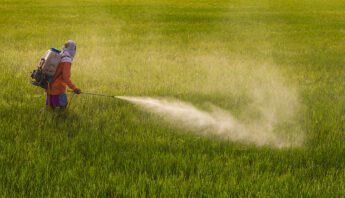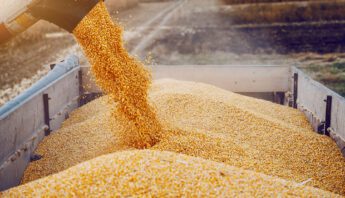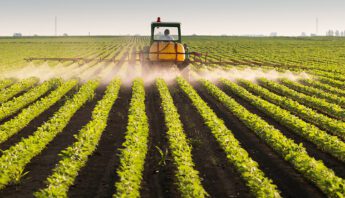In a 2015 poll, 90 percent of Iowa farmers reported feeling that “pest management is a never-ending technology treadmill.” Each round of newly pesticide-resistant “superweeds” and “superbugs” can keep farmers tethered to new, expensive seed/pesticide packages.
And crop and livestock losses from drifting pesticides can be financially devastating.
The threat of legal challenges for patent violations from corporations like Bayer (now merged with Monsanto) creates additional financial stress and uncertainty. With the farm-to-fork price spread continuing to widen — farmers now receive about 20 cents of every dollar spent on food — it can be hard to make a living on the farm.
Weeds, pesticides & drift
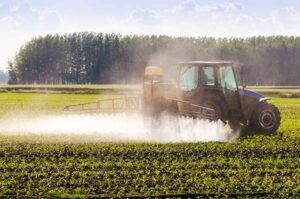 Farmers now face a disastrous epidemic of RoundUp-resistant “superweeds” on U.S. farms — at least 60 million acres are affected. The new GE crops intended to fix the mess left by RoundUp — like 2,4-D-resistant corn — are designed for use with antiquated, hazardous and drift-prone herbicides that represent a further threat to farmer livelihoods.
Farmers now face a disastrous epidemic of RoundUp-resistant “superweeds” on U.S. farms — at least 60 million acres are affected. The new GE crops intended to fix the mess left by RoundUp — like 2,4-D-resistant corn — are designed for use with antiquated, hazardous and drift-prone herbicides that represent a further threat to farmer livelihoods.
Farmers growing fruits, vegetables, non-GMO crops and specialty crops like wine grapes have the most to lose. Herbicides drifting from a neighbor’s farm can wipe out an entire season’s worth of crops for these farmers, with hundreds of thousands of dollars on the line. Organic farmers are at particular risk since they can lose their hard-won certification.
Then there’s the fact that the pest control trait in Bayer’s (Monsanto) Bt corn, genetically modified to protect the plants from rootworm, is no longer working. As a result, many farmers have had to ramp up use of insecticides to protect their crops.
Clearly, our current reliance on chemical inputs is putting farmer livelihoods at risk.
Who owns seeds?
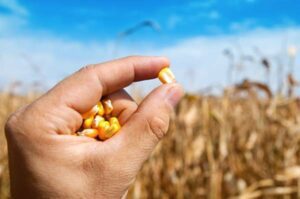 Saving seed has been a farming practice for millennia. Now the threat of seed patent lawsuits — and the financial ruin it can create — hovers over many farm communities.
Saving seed has been a farming practice for millennia. Now the threat of seed patent lawsuits — and the financial ruin it can create — hovers over many farm communities.
For years now, farmers have been forced to pay for ever more expensive seeds that don’t perform as advertised, and are increasingly the only market-viable (i.e. “elite”) seeds they can find. When they look to other seed sources, they are dogged by the threat of patent infringement lawsuits.
As of January 2013, Monsanto (now merged with Bayer) had filed 144 suits against 410 farmers in 27 states. So far the corporation has collected over $423.5 million from farmers and farm businesses in the courtroom, as documented in Seed Giants vs U.S. Farmers, a report from our friends at the Center for Food Safety and Save Our Seeds.
And market consolidation marches on. Worldwide, four corporations control more than a third of the global seed supply. When it comes to corn, just two corporations — Bayer (Monsanto) and DowDuPont — control nearly two thirds of the global market.
Women farmers shift landscape
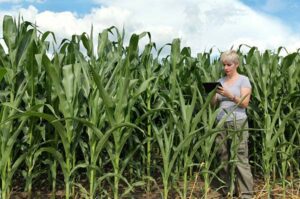 Women are the fastest growing group of farm owners in the country. Of the 3.2 million U.S. farmers counted in the 2012 Census of Agriculture, nearly one million were women. In Iowa, almost half of the land is now held by women.
Women are the fastest growing group of farm owners in the country. Of the 3.2 million U.S. farmers counted in the 2012 Census of Agriculture, nearly one million were women. In Iowa, almost half of the land is now held by women.
On a global scale, women make up 60 percent of the world’s agricultural labor, and produce 60 to 80 percent of the world’s food, according to the UN Food and Agricultural Organization.
Women in the U.S. are three times more likely to run an organic or sustainable farm than an industrial one. According to the Women, Food & Agriculture Network (WFAN), farmers in their network are guided by an ethic to “nourish, rather than poison, the earth” — which means fewer pesticides in our air, soil and communities.
These are the very values we’d like to see guiding state and federal farm policies, and building vibrant local food economies across the country. WFAN founder and PAN board member Denise O’Brien shares her perspective on the trend:
My dream is that the landscape of industrialized agriculture will change as women become the decisionmakers on their land.





